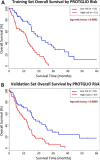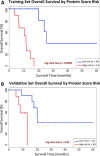Protein Markers Predict Survival in Glioma Patients
- PMID: 27143410
- PMCID: PMC4937509
- DOI: 10.1074/mcp.M116.060657
Protein Markers Predict Survival in Glioma Patients
Abstract
Glioblastoma multiforme (GBM) is a genomically complex and aggressive primary adult brain tumor, with a median survival time of 12-14 months. The heterogeneous nature of this disease has made the identification and validation of prognostic biomarkers difficult. Using reverse phase protein array data from 203 primary untreated GBM patients, we have identified a set of 13 proteins with prognostic significance. Our protein signature predictive of glioblastoma (PROTGLIO) patient survival model was constructed and validated on independent data sets and was shown to significantly predict survival in GBM patients (log-rank test: p = 0.0009). Using a multivariate Cox proportional hazards, we have shown that our PROTGLIO model is distinct from other known GBM prognostic factors (age at diagnosis, extent of surgical resection, postoperative Karnofsky performance score (KPS), treatment with temozolomide (TMZ) chemoradiation, and methylation of the MGMT gene). Tenfold cross-validation repetition of our model generation procedure confirmed validation of PROTGLIO. The model was further validated on an independent set of isocitrate dehydrogenase wild-type (IDHwt) lower grade gliomas (LGG)-a portion of these tumors progress rapidly to GBM. The PROTGLIO model contains proteins, such as Cox-2 and Annexin 1, involved in inflammatory response, pointing to potential therapeutic interventions. The PROTGLIO model is a simple and effective predictor of overall survival in glioblastoma patients, making it potentially useful in clinical practice of glioblastoma multiforme.
© 2016 by The American Society for Biochemistry and Molecular Biology, Inc.
Conflict of interest statement
The authors declare no conflicts of interest.
Figures


References
-
- Stupp R., Mason W. P., van den Bent M. J., Weller M., Fisher B., Taphoorn M. J., Belanger K., Brandes A. A., Marosi C., Bogdahn U., Curschmann J., Janzer R. C., Ludwin S. K., Gorlia T., Allgeier A., Lacombe D., Cairncross J. G., Eisenhauer E., Mirimanoff R. O., European Organisation for, R., Treatment of Cancer Brain, T., Radiotherapy, G., and National Cancer Institute of Canada Clinical Trials, G. (2005) Radiotherapy plus concomitant and adjuvant temozolomide for glioblastoma. New Eng. J. Med. 352, 987–996 - PubMed
-
- Lacroix M., Abi-Said D., Fourney D. R., Gokaslan Z. L., Shi W., DeMonte F., Lang F. F., McCutcheon I. E., Hassenbusch S. J., Holland E., Hess K., Michael C., Miller D., and Sawaya R. (2001) A multivariate analysis of 416 patients with glioblastoma multiforme: Prognosis, extent of resection, and survival. J. Neurosurgery 95, 190–198 - PubMed
-
- Noushmehr H., Weisenberger D. J., Diefes K., Phillips H. S., Pujara K., Berman B. P., Pan F., Pelloski C. E., Sulman E. P., Bhat K. P., Verhaak R. G., Hoadley K. A., Hayes D. N., Perou C. M., Schmidt H. K., Ding L., Wilson R. K., Van Den Berg D., Shen H., Bengtsson H., Neuvial P., Cope L. M., Buckley J., Herman J. G., Baylin S. B., Laird P. W., Aldape K., and Cancer Genome Atlas Research, N. (2010) Identification of a CpG island methylator phenotype that defines a distinct subgroup of glioma. Cancer Cell 17, 510–522 - PMC - PubMed
-
- Phillips H. S., Kharbanda S., Chen R., Forrest W. F., Soriano R. H., Wu T. D., Misra A., Nigro J. M., Colman H., Soroceanu L., Williams P. M., Modrusan Z., Feuerstein B. G., and Aldape K. (2006) Molecular subclasses of high-grade glioma predict prognosis, delineate a pattern of disease progression, and resemble stages in neurogenesis. Cancer Cell 9, 157–173 - PubMed
MeSH terms
Substances
Grants and funding
LinkOut - more resources
Full Text Sources
Other Literature Sources
Medical
Research Materials

